By Laura Coltofean-Arizancu, Postdoctoral Researcher
Overwhelming, breathtaking landscapes. A very long way from home. Those are the words that come to mind whenever I think about the Artsoundscapes Project expedition to Siberia. We’re now back in Barcelona and I’m writing this blog post three weeks after our return. I was supposed to write it earlier, but it was such a powerful experience that I felt I needed create some space in between to allow me to assimilate it all and to be able to put it into words. “Why Siberia?” is a question we were often asked before we left. The answer was simple. Siberia is one of the richest areas in rock art and is also the heartland of shamanism in its classical form. It was therefore a must-see destination for a project that explores the relationship between sound, rock art and sacred landscapes (read more about our project’s aim here). “What was it like in Siberia?” is another question we have been asked daily since we came back. Siberia is not a common destination for European archaeological expeditions; nor even for foreign tourists. It is therefore no wonder that everybody was so surprised and curious about it. In this post I will try and answer the numerous questions raised by our fellow archaeologists, colleagues from other disciplines and family and friends about our stay in that fascinating region of the world.
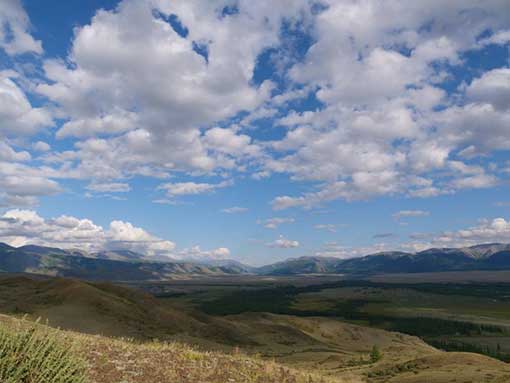
Siberian landscape
Our expedition began on 6 August 2019 and lasted three weeks. The members of our team were Margarita Díaz-Andreu (Artsoundscapes Project Principal Investigator), Tommaso Mattioli (senior postdoctoral researcher), Laura Coltofean-Arizancu (junior postdoctoral researcher), Adriano Farina (acoustical engineer) and Elliot Smith (student collaborator). Our aim was to perform acoustic measurements at several rock art sites in Siberia, more specifically in the Altai Republic. This is the least populated republic in Russia and what I find particularly captivating about it is that most of its territory is covered by mountains (the Altai Mountains). After a month of intensive preparations, we finally embarked on the long-awaited flight from Barcelona to Moscow. In the airport of the Russian capital we met Andrzej Rozwadowski, a Polish archaeologist specializing in rock art and one of the collaborators of the Artsoundscapes project. He has published widely on shamanism in Siberia and has often carried out fieldwork there, which is why we approached him months ago to be part of the team. With Andrzej on board, we landed at Gorno-Altaysk, the capital of the Altai Republic, on 7 August, after a long and delayed flight.
At Gorno-Altaysk airport we were welcomed by the three Russian members of the expedition, Elena Miklashevich, Leonid Bove and Vasiliy Blinov. Elena is one of the most knowledgeable archaeologists in Russia on rock art studies. She works at the Tomskaya Pisanitsa Museum and the Moscow Institute of Archaeology of the Russian Academy of Sciences. She was accompanied by two of her former archaeology students, Leonid, who works as an ambulance doctor, and Vasiliy, now a photographer. They were waiting for us with two off-road vehicles.
We were supposed to spend the first night in Gorno-Altaysk so that we could rest after the long flight and the time zone changes. We therefore went to the accommodation that had been booked for us by our university’s travel agency. To our amusement, it turned out to be a luxurious hotel outside the capital with a casino. It was certainly not what we expected. The reception staff were also amazed, as they were not used to guests like us: strange-looking archaeologists dressed for fieldwork and with a huge amount of suspicious luggage. The incompatibility was clear from both sides, so Vasiliy quickly found us simpler and less expensive accommodation in a tourist camp near the town. In the afternoon we visited the A.V. Anokhin National Museum in Gorno-Altaysk, the national museum of the Altai Republic. Besides its palaeontological, ethnological, mineral and fine art collections, the museum also hosts a large and very interesting archaeological collection with artefacts from the Palaeolithic to the Late Middle Ages. Here we also had the chance to see the coffin and burial reconstruction of the world-famous Siberian Ice Maiden or Princess of Ukok, known for her impressive tattoos depicting deer. Later in the evening we were introduced to Russian cuisine and the next morning we were already driving deep into the mountains, heading south to our first destination.
During our expedition we had three major stops in Beliy Bom, Kurota and Chemal, villages that had been chosen in advance by Leonid and Elena to be our accommodation and base camps. It was from those places that we explored the nearby rock art sites. In Beliy Bom we were accommodated in a tourist camp located at the foot of mountains on the bank of the fast-flowing Katun River. The camp included several ails (the traditional Altai house, a hexagonal wooden building with one room and a high, pointed roof). In our case, the ails contained five beds, an oven and a large, low, round table in the middle surrounded by small chairs. Altaic families that still live in them gather and eat sitting around those tables. This is also where we enjoyed our dinners on the coldest evenings and they were perhaps some of our nicest meals. I felt that sitting next to each other in circle and being able to see each other closely really had a positive effect on us. Socializing was easier and we felt more like a team.
The very simple living conditions in Beliy Bom came as a shock at first, but we slowly got used to them. There was no bathroom of course and we only had two outdoor latrines. We washed in the antechamber of the sauna (which had to be requested and heated in advance). Our personal hygiene was a ritual-like process that involved preparing our own water by mixing the different pots of hot and cold water until we obtained a suitable temperature for washing our bodies. Sometimes before “showering” we spent time in the dry sauna and then went outside and jumped into an inflatable pool full of ice-cold water. I mentioned several times during the expedition that Beliy Bom was my favourite accommodation during our stay in the Altai. I have the same opinion now, three weeks after our return. After Beliy Bom, the accommodation got better and better in terms of comfort (although the toilets were still outside). In the next village, Kurota, we slept in small wooden houses with one room and twin beds in the courtyard of our dear host Irina. Later on, in Chemal, we were accommodated in the beautiful wooden houses of a spotlessly clean tourist camp, which was kept alive by a tireless woman who worked 24/7.
Whenever we moved to a new place, Elena, Leonid and Vasiliy first took us to explore the rock art sites of the area so that we could plan and decide where to take the next acoustic measurements. During our stay we took measurements at well-known rock art sites that we grouped into four working areas. These sites were Kalbak-Tash I, Kalbak-Tash II and Adyrgan in the first area; Urkosh and Grand Yaloman in the second area; Kara-Tuu, Bichiktu-Bom, Talda and Torgun in the Karakol Valley, our third area; and finally the fourth area, Kuyus, which is along the sacred Katun River. The rock art in the regions where we worked in the Altai Republic is superb and simply everywhere! From cliffs and horizontal rock surfaces to stone slabs and random stones, often, but not necessarily, near rivers; there seemed to be rock art wherever we looked! It is so widespread that it was sometimes difficult to find a place without depictions for our comparative measurements.
At the sites we chose to examine, the rock art can mainly be dated from the Neolithic (in this area between the second half of the fourth millennium and the beginning of the third millennium BC) to the Early Modern Period and even the present day (graffiti). Depictions from different periods can quite often be found at the same site; for example at Kalbak Tash I, which comprises more than 5000 rock art representations with the earliest being from the Neolithic and the latest from the Late Middle Ages. The figures depicted in the Altai Mountains consist mainly of animals (deer, goats, boar, horses, bears, snakes, etc.), anthropomorphs (sometimes with mushroom-shaped hats), cup marks, abstract motifs and sometimes small compositions representing hunting or perhaps ritual scenes.
We were particularly thrilled by engravings depicting shamans and shamanic drums that we saw in a couple of places in the Karakol Valley. The various techniques used to create these rock art images in the Altai included pecking, carvings, incisions, engravings and scratchings. Some of depictions may also have been painted. There are many interesting examples where the same stone surface has been reused by peoples from different periods using different methods. Their creative processes have resulted in fascinating layers of overlapping figures that we now speechlessly admire and research in our attempt to understand them.
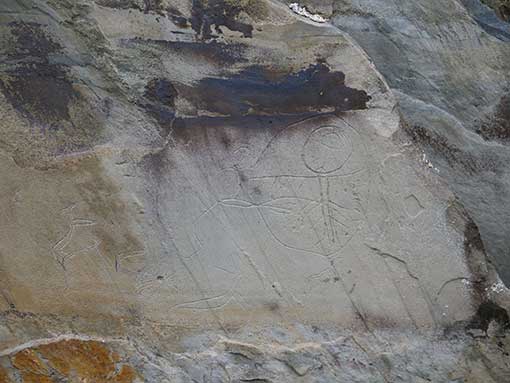
Shaman and drum in the Karakol Valley
Siberia was the first time we had used our newly built and purchased acoustic measurement equipment on a large-scale expedition such a long way from our base in Barcelona. We had tested it in June during our fieldwork in Ulldecona (Spain), but there we were close to Catalonia and the university. If anything had happened, we had easily accessible solutions. In the Altai, however, we were far from everything. There was quite a high risk of our sensitive equipment being damaged during flights or on road trips over the rough terrain we crossed in Siberia. The possibility of repairing the equipment or replacing certain components were, however, limited. Our fears came true in the first days of the expedition, when everything seemed to be against our measurements. Our precious, purpose-built loudspeaker failed a couple of times as the complicated network of cables inside it had moved as a consequence of the trip. Tommaso and Adriano had to perform complicated “surgery” on the loudspeaker a couple of times to fix it. One of our digital recorders and the leg of one of the best Manfrotto tripods on the market also broke. We were disappointed and concerned. We even started joking that we had upset the spirits of the area and turned them against us. A native Altaic man would later tell us that this often happens to archaeologists who disturb the sacredness of the land with their work and insatiable curiosity!
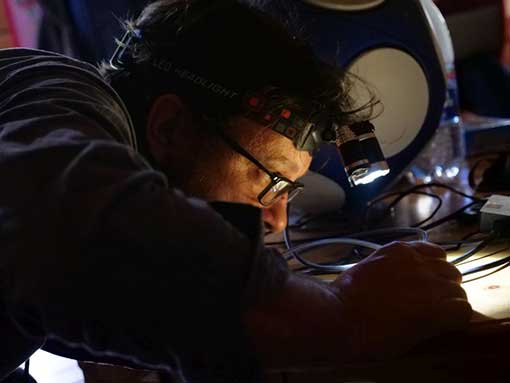
Tommaso performing “surgery” on the loudspeaker
Our difficulties did not end with the equipment. The weather was also often against us. Instead of the lovely summer weather we had been promised, we were confronted by many rainy days that prevented us from working in the field. On those days we usually focused on meeting with local Altaic people, writing our diaries and pre-processing the data we already had. At the most famous rock art sites where we took measurements we also had to do as much as possible to avoid coinciding with the increasing numbers of tourists, most of them Russian, who, by making noise (talking or slamming their car doors), interrupted or disturbed our measurements. Some of the rock art sites are also located along the Chuysky Tract leading to Mongolia, meaning the traffic was quite intense and the noise almost constant. All this meant that we had no time to lose in the field. We had to move fast and take the measurements as quickly as possible while the conditions were optimal. There were several days when Marga, Tommaso and Adriano woke up very early in the morning and went out into the field before the rest of the team to be able to take measurements before the tourists arrived. However, against all the odds, we were able to undertake all the planned measurements and we even finished them a day earlier than initially scheduled. We were both pleased and relieved. It seems that the spirits were not against us after all and we now have a good set of data waiting to be processed at the university.
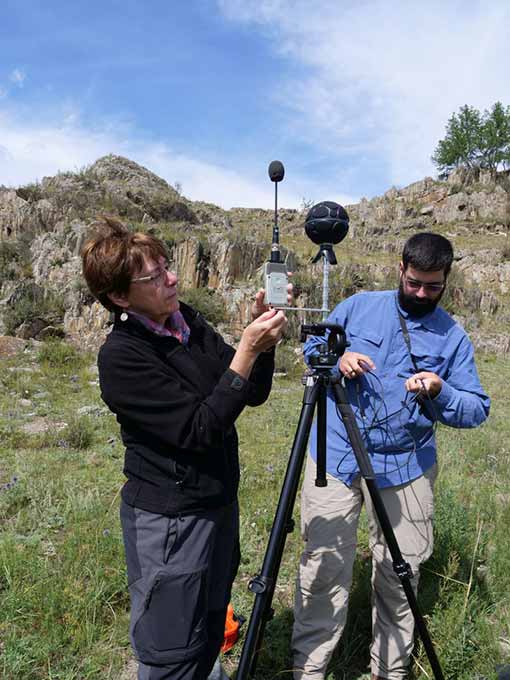
Marga and Adriano preparing the equipment for acoustic measurements in the Karakol Valley
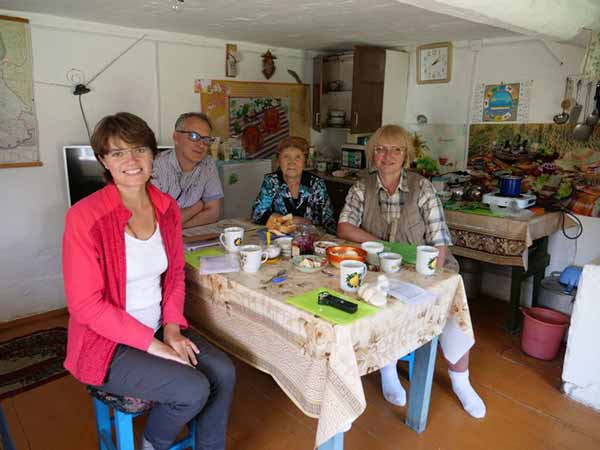
Laura, Andrzej, Marija and Elena talking about Altaic traditions
